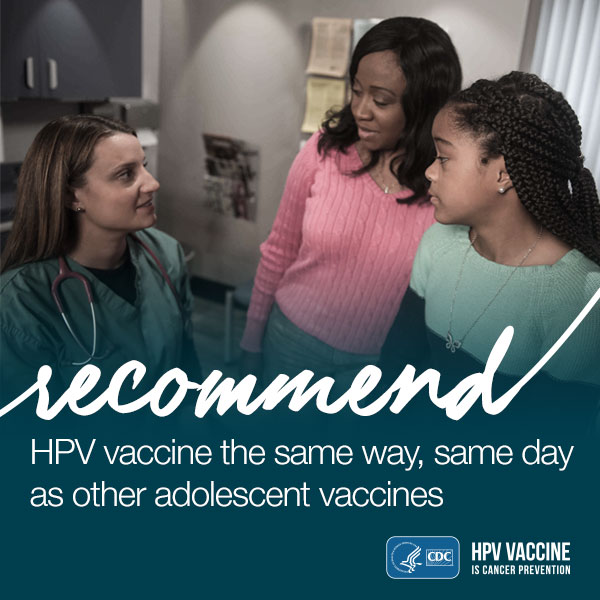5 Ways to Boost Your HPV Vaccination Rates

Human papillomavirus (HPV) causes 33,700 new cases of cancer each year. As a healthcare provider, it is more important than ever to create a culture of immunization in your practice. This means getting your whole office involved in HPV cancer prevention through communicating effectively with parents about HPV vaccination and implementing systems to ensure all your preteen patients are vaccinated. Read five ways to boost your office’s HPV vaccination rates.

1. Recommend HPV vaccine the same way, same day as other adolescent vaccines
Increase vaccination rates by bundling your recommendation for all adolescent vaccines, including HPV vaccine, in the same way, on the same day. You can start the vaccine discussion with, “Now that your child is 11, he/she needs three vaccines to help protect against meningitis, HPV cancers, and whooping cough. We’ll give these shots during today’s visit. Do you have any questions about these vaccines?”

2. Create a culture of immunization in your office
All of your office staff should receive training on how to successfully communicate with parents and patients about HPV vaccination and adolescent immunizations. Starting with the front office, make sure that everyone is on the same page when it comes to proper vaccination practices, recommendations, and how to answer parents’ questions.


3. Implement systems to ensure you never miss an opportunity to vaccinate
Establish a policy to check patients’ immunization status at every visit and always recommend and administer vaccines your patients need. Call to remind families about getting vaccines if they fall behind schedule or need follow-up doses to complete the HPV vaccine series. Develop a process where all clinicians in your practice compare HPV vaccination rates to rates of meningococcal and Tdap vaccination. Employ the following tips:
- Print a registry of all patients 13 years old and older who haven’t initiated the HPV vaccination series and contact parents periodically until series is completed.
- Use standing orders for nurses to administer HPV vaccine, and offer nurse-only or “no wait” walk-in appointments for second or third doses.
- Allow appointment scheduling for up to six months in advance and encourage parents to schedule a follow-up appointment before they leave your office.
- Work closely with your local immunization program and request an HPV vaccination-focused quality improvement visit. This can help identify specific strategies for your office to improve HPV vaccine uptake.

4. Share how your family has been vaccinated
Providing personal examples of how you support vaccinations for your family members shows you believe they are important. Share how you recommended or administered HPV vaccine for your own children, grandchildren, nieces, or nephews. Sharing your personal experience may be part of an effective recommendation that allows parents to better understand the importance of HPV vaccination and be more comfortable in their decision to vaccinate their child.


5. Learn how to answer some of parents’ most common questions about HPV vaccine
Be prepared to answer parents’ questions succinctly, accurately, and empathetically by using terms that they understand. A parent will often accept your explanations if presented with their children’s best interests in mind.
For more information, visit CDC’s HPV website for clinicians.